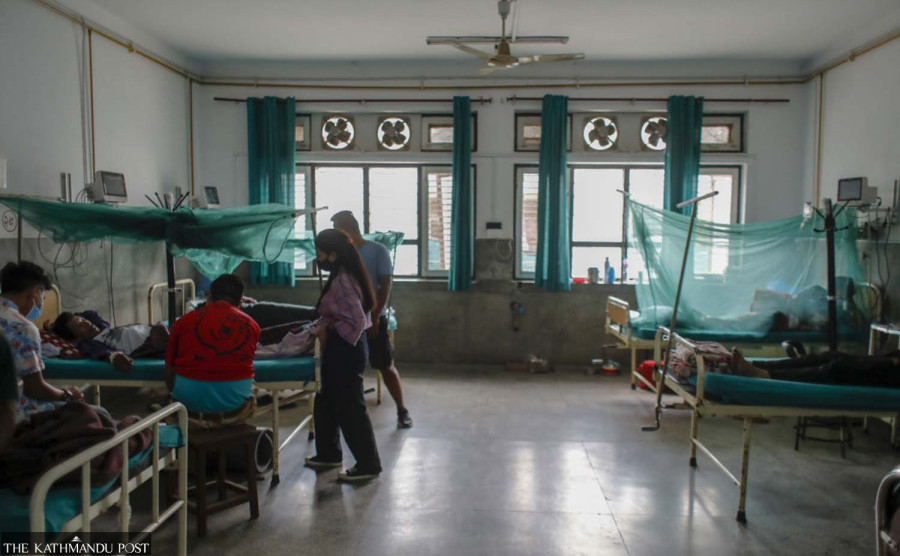Health
Dengue infection overshadows Covid and other diseases
Doctors suspect another dengue serotype might be responsible for the surge in new cases. People having comorbidities are at high risk of getting severe and dying due to dengue.
Arjun Poudel
On Wednesday morning, a 35 year-old-man from Dhading, infected with dengue virus died at Sukraraj Tropical and Infectious Disease Hospital. Doctors at the hospital said that the deceased was referred by a local health facility in Dhading on Tuesday evening and had been suffering from liver disease.
“Along with dengue infection, the man had other health complications also,” said Dr Manisha Rawal, director at the hospital.
Doctors say dengue infection has overshadowed Covid and other diseases, and like in Covid, people having other health issues are at risk of getting severe and dying if infected with the dengue virus.
“Dengue cases have overshadowed Covid and other diseases,” said Dr Sher Bahadur Pun, chief of the Clinical Research Unit at Sukraraj Hospital.
With the new death on Wednesday, the number of deaths from the dengue virus has reached at least five. The Health Ministry, however, has confirmed only two deaths from infection by the virus. Officials said that other people who died of dengue infection had other health issues also.
Dengue is transmitted by female Aedes aegypti or Aedes albopictus mosquitoes, after they bite a person. The same vector also transmits chikungunya, yellow fever, and Zika viruses, according to the World Health Organisation.
So far, 6,707 people have been infected with the dengue virus that has spread to 75 districts of the 77 throughout the country.
Hospitals in the Kathmandu Valley have reported a massive surge in dengue cases.
With a significant rise in dengue cases throughout the country, blood banks in the Kathmandu Valley have been struggling to meet the growing demand for platelet components.
According to the Central Blood Transfusion Service, popularly known as the blood bank, there are demands for 150 to 200 pints of platelet-rich plasma and platelet concentrate every day.
Of the total infections, over 70 percent are in 10 districts, including Lalitpur, Kathmandu, and Makawanpur , according to officials. They say office-goers and school children have been infected in large numbers.
Doctors say another serotype of dengue might be responsible for the current surge in new dengue cases, as the country witnessed a massive dengue outbreak in 2019.
At least six people died and over 17,000 were hospitalised with dengue fever. The outbreak, which had started in the pre-monsoon period from Dharan, spread to 68 districts.
Doctors suspect another serotype of dengue virus might be responsible for the current spike in new cases.
“All four serotypes of dengue virus have been found in Nepal, and some patients who have been infected with the virus reported that they were infected earlier too,” said Pun. “Test also confirmed immunoglobulin G (IgG) in the same patients, which means the patients were likely infected with dengue virus in the past.”
Mosquitoes that cause dengue breed in clean water and infect people in daylight. Uncovered water tanks and discarded plastic cups and bottles could also shelter dengue-carrying mosquitoes.
According to doctors, mild to high fever, severe muscle pain, rashes, severe headache, pain in eyes, and vomiting are some of the symptoms of dengue.
Abdominal pain, vomiting, bleeding from the gums and nose, vomiting blood and blood in stool, tiredness, and restlessness are symptoms of severe dengue.
Severe dengue is the leading cause of serious illness and death, doctors say.
Disposing of solid waste properly, covering or emptying water storage containers, using personal household protection such as window screens, and wearing long-sleeved clothes are some measures to prevent infection.
With the massive outbreak of dengue infection, the Health Ministry has urged all the agencies concerned to carry out awareness and dengue search and destroy drives.
“We held meetings with physicians serving in major hospitals in the Kathmandu Valley and over 100 hospitals outside Valley and told them about the ways of treatment and diagnosis,” said Dr Gokarna Dahal, chief of the Vector Control Section at the Epidemiology and Disease Control Division. “As the dengue epidemic is at its peak, we told the doctors that laboratory confirmation is not necessary in all cases and clinical diagnosis can be carried out to start the treatment.”
Meanwhile, the Health Ministry said that it has been preparing to carry out a nationwide seroprevalence survey of the dengue virus with the technical assistance of the World Health Organisation.
A seroprevalence survey is a study carried out to determine the extent of infection in the general population.
Officials said they are also preparing to carry out vector surveillance of dengue spreading mosquitoes in all seven provinces.
Nepal has witnessed outbreaks of dengue in the pre-monsoon, monsoon, and post-monsoon seasons, although the post-monsoon period is considered a high transmission season for the virus.
As the monsoon is still continuing and the post-monsoon season is yet to start, health officials say the dengue infection rate could go up in the coming days. The dengue-spreading mosquitoes survive up to 45 days and their entire generation gets infected with the virus, meaning that they can transmit the same virus.
The UN health agency says there is no specific treatment for severe dengue, but early detection and access to proper medical care can lower the fatality rate.




 10.12°C Kathmandu
10.12°C Kathmandu













%20(1).jpg&w=300&height=200)
